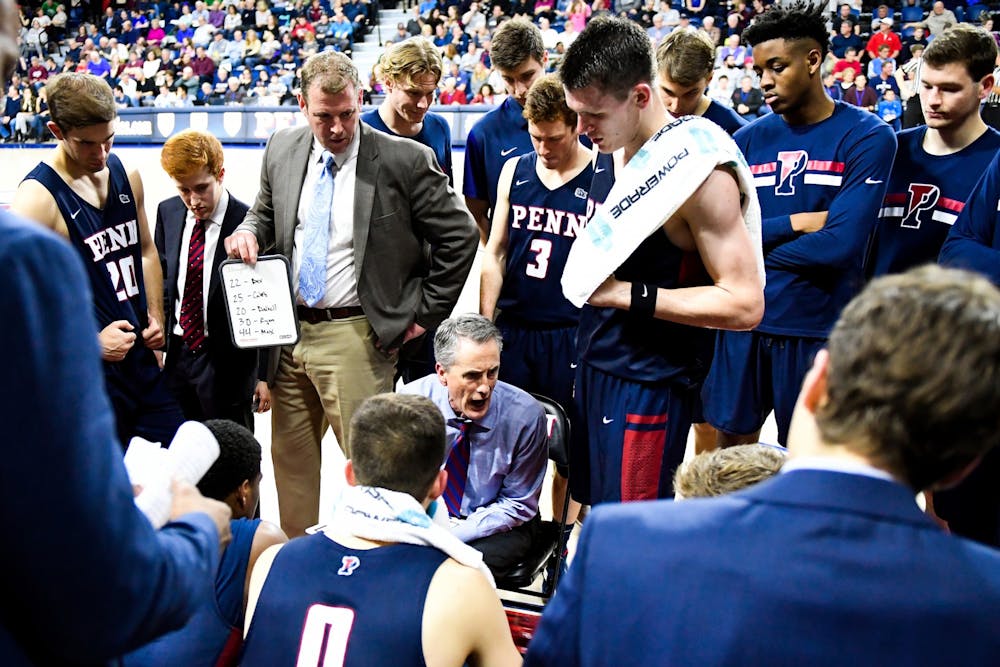College basketball coaches are often defined by the game plans and style of play that they rely on during games.
Their strategy is pivotal in attracting recruits, winning games, and creating a legacy at their respective school. For Penn men’s basketball, the man behind the clipboard is Steve Donahue, whose approach to coaching is more nuanced than the average fan may realize.
Donahue joined the Quakers in 2015, after coaching stints at both Cornell and Boston College. Since taking over, Donahue has become known primarily for his unique offensive approach: the 95 and 5 rule, sometimes also called the 95% rule.
This approach requires that 95% of Penn’s offensive shots are either open three-pointers or at-the-basket layups. This principle limits the amount of low percentage mid-range jump shots that often detract from a team’s shooting efficiency.
The principle has its roots in Donahue’s earlier coaching days when he was in search of a guiding concept that he could build his offense around.
“When I went to [Boston College], and I wanted to teach how we have to play, it was more of a concept that the kids could really grasp and understand,” Donahue said. “As [I] came to Penn, we did it a lot more. It helps us look at the game more conceptually in what we’re trying to accomplish on offense.”
Despite being well-known as the centerpiece of Donahue’s offensive philosophy, the rule is not a defined way of playing basketball. Instead, it is merely an overarching concept used to tie the program together.
“When I took over the program, I just thought the easiest way to grow the program was to keep it really simple and put some parameters on what we’re trying to do,” Donahue said. “Then, [we] reinforce it with the coaching behavior [strategies].”
Donahue knows that sticking solely to a coaching philosophy can lead to missed opportunities and underutilized players. As a result, he emphasizes knowing his personnel well enough to be able to adapt his strategies as needed.
“One of the key things I love to do is just see what kids are good at,” Donahue said. “[For example], I think [sophomore forward] Max Martz is a good mid-range shooter, so you still [have] to figure out how you’re going to get key buckets at times. So, for example, I don’t discourage him.”
Martz is an example of a player whose skill set can thrive when there’s increased flexibility in the game plan. However, even when a player has those additional strengths, they still prioritize the philosophy that Donahue has woven into the program’s culture.

Sophomore guard Jordan Dingle attempts a three-pointer in a game versus Temple.
“I think our offense is mainly focused on getting the highest-percentage shot that we can possibly take,” Martz said. “In college basketball especially, that’s open [three-pointers] and then shots around the rim. At least for the past few years, that’s what Penn basketball has been about.”
How exactly does Donahue get players to buy into the offensive strategy? He integrates it into all aspects of the team’s game preparation so that playing Penn basketball becomes synonymous with displaying the tendencies he has built his program around.
“When we scrimmage in practice, we put a little scoring system in place on shot quality,” Donahue said. “If guys are going to take difficult ones, or better yet, if we force others to take difficult ones in practice, then your teammates will let you know either way.”
While Donahue has had success in creating and implementing his offensive philosophy, he also realizes the importance of translating this success to the defensive end as well.
“We look at the defensive end [analytics] as well,” Donahue said. “We’re looking to reduce the shot quality for our opponents. Force long [two-pointers] and mid-range shots [while] limiting three-pointers. Those are the ways to be efficient.”
It's clear that Donahue takes a careful approach to implement his coaching strategy. He is careful not to stick to his game plan too much, but he also ensures that the offense stays on track by making his principles easy to digest and understand.
Donahue has proven that a coach’s offensive philosophy is often far too complicated to be broken down into a single “rule.” While they may not be all-encompassing, the rules are useful in getting players to buy-in to the program and develop discipline in shot selection.
The process of developing offensive strategy is also an ongoing one, and when Penn basketball returns to play, fans will likely see Donahue further update the way he approaches coaching the game.









